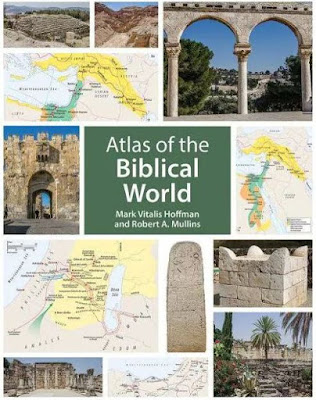Mark V. Hoffman and
Robert A. Mullins, Atlas of the Biblical World. Minneapolis:
Fortress Press, 2019.
It
was in second grade, I think, that everyone in my class received a
state map. We didn’t do much with it, but it was a fold-up wonder
that opened a new world. Looking at it, I saw where we lived, places
nearby that we sometimes traveled to, and places further off that
sounded fascinating. Thus began an interest that developed as I
pursued historical studies—learning how geography has had an
integral role in shaping events, and growing in understanding how
others live.
As
I moved into a major of religious history, it seems natural to say
that Bible atlases were along for the journey. More so than for many
other books, one is needed here—its events take place in a
generally unfamiliar land, there are often varying accounts of an
event, as well as different names than other sources use, and other
problems that challenge a reader. Bible publishers have responded
with maps bound in with the text, but they are often dated and
require flipping pages, so a stand-alone version that can sit next to
one is a useful resource. Mine received a lot of use; I suspect I’m
not alone in wearing out copies of the Oxford Bible Atlas just
in time to buy a new edition.
While
the Oxford atlas remains a good choice, this recent offering from
Fortress provides worthy competition. In general, each page has a
section outlining the text references, books or chapters and
background on one leaf. Opposite that is a map illustrating the
geography and movements involved. There are five sections that flow
chronologically: Beginnings, The People of Israel in Canaan, A People
Divided, Invasion and Occupation, and Jesus and the Emergence of
Christianity.
I
mention this organization to remember one of my seminary professors
who remarked of one paper that simply being aware that the book of
Jeremiah is not in chronological order is useful. The Hebrew Bible is
organized by themes – Torah, Prophets, and Writings. While the role
and places of the prophets are often missing here (which I see as the
book’s greatest lack), the whole does a good job of helping make
the storyline of the Hebrew Bible clear.
The
Christian scriptures start with five books that are only vaguely in
chronological order (like the Hebrew records, a trait that often
frustrates modern western readers), and often alludes to events that
are obscure. It then pries into someone else’s mail, often
conjoining the letters and obscuring the background of events. Here
the layout and background are again useful.
Overall this approach is helpful as the authors relate the biblical stories to
other historical events, thus removing some of the “bubble.” It’s
easy to forget about the wider world, one that is only tangentially
mentioned most of the time. Another helpful feature is reference to
archaeological findings and what they tell us about the story.
Archaeology doesn’t “prove” the Bible, but it does tell us a
lot about the background of the stories, and thus help us understand
it. The section “Invasion and Occupation,” dealing mostly with
the inter-testamental period (when much of the Apocrypha were
composed) is particularly good in helping to understand the political
movements which led to the tensions, situations, and parties of the
Gospels.
In
summary, then, this a very
effective tool for understanding. It’s
not the most comprehensive,
but that isn’t the goal.
It’s factual, which means that some of the popular legends aren’t
included, but that’s fine with me. Mark
Twain wrote in the conclusion of his rollicking book The Innocents Abroad that “travel is fatal to
prejudice, bigotry, and narrow-mindedness.” It
also is fatal to fakery (something Twain remarks on a lot in
that book!) and expands
horizons and knowledge. You
may well find me online, looking at Google maps (especially with the
new accessibility features, but
stretching our boundaries
also includes a good book of
this sort.


No comments:
Post a Comment